Application of Hydrological Model PRMS to Simulate Daily Rainfall Runoff in Zamask-Yingluoxia Subbasin of the Heihe River Basin
Abstract
:1. Introduction
2. Hydrologic Model Descriptions
3. Hydrologic Model Setup
4. Boundary Conditions
5. Daily Flow Modeling
5.1. Model Calibration
5.2. Model Verification
6. Discussion
7. Conclusions
Acknowledgments
Author Contributions
Conflicts of Interest
References
- Kang, E.; Cheng, G.; Lan, Y. A model for simulation the response of runoff from the mountains watersheds of inland river basins in the arid area of northwest China to climate changes. Sci. China Ser. D Earth Sci. 1999, 29, 48–54. [Google Scholar]
- Zou, S.B.; Ruan, H.W.; Lu, Z.X.; Yang, D.W.; Xiong, Z.; Yin, Z.L. Runoff Simulation in the Upper Reaches of Heihe River Basin Based on the RIEMS–SWAT Model. Water 2016, 8, 455. [Google Scholar] [CrossRef]
- Yi, Q.; Chen, X.; Xie, Y. Comparison and analysis between flood event 52.7 and 96.8 in Heihe River Basin. Inn. Mong. Water Resour. 2004, 97, 60–61. [Google Scholar]
- Ratha, D.; Sarkar, A. Analysis of flow over backward facing step with transition. Front. Struct. Civ. Eng. 2015, 9, 71–81. [Google Scholar] [CrossRef]
- Cai, Y.; Huang, W.; Teng, F.; Gu, S. Effects of changing climate on glacier shrinkage and river flow in the Upper Heihe River Basin, China. J. Coast. Res. 2014, 121–128. [Google Scholar] [CrossRef]
- Wang, G.; Liu, J.; Kubota, J.; Chen, L. Effects of land-use changes on hydrological processes in the middle basin of the Heihe River, northwest China. Hydrol. Process. 2007, 32, 1370–1382. [Google Scholar] [CrossRef]
- Jiao, W.; Xu, Z. A distributed runoff model for the mountainous region of the Heihe River Basin (China) based on the spatial modeling environment (SME) I: Model structure and equations. Environ. Earth Sci. 2013, 68, 881–888. [Google Scholar] [CrossRef]
- Jiao, W.; Xu, Z. A distributed runoff model for the mountainous region of the Heihe River Basin (China) based on the spatial modeling environment (SME) II: Model calibration and validation. Environ. Earth Sci. 2013, 69, 2189–2197. [Google Scholar] [CrossRef]
- Nian, Y.; Li, X.; Zhou, J.; Hu, X. Impact of land use change on water resourceallocation in the middle reaches of the Heihe River Basin in northwestern China. J. Arid Land 2014, 6, 273–286. [Google Scholar] [CrossRef]
- Cai, Y.; Huang, W.; Teng, F.; Wang, B.; Ni, K.; Zheng, C. Spatial variation of river-groundwater interactions from upstream mountain to midstream oasis and downstream desert in Heihe River Basin, China. Hydrol. Res. 2015, 47, 501–520. [Google Scholar] [CrossRef]
- Tian, Y.; Zheng, Y.; Wu, B.; Wu, X.; Liu, J.; Zheng, C.M. Modeling surface water-groundwater interaction in arid and semi-arid regions with intensive agriculture. Environ. Model. Softw. 2015, 63, 170–184. [Google Scholar] [CrossRef]
- Huang, W.; Cai, Y.; Chao, Y.N.; Teng, F.; Xu, S.D.; Wang, B.B. Neural Network Modelling of Flow in Yinluoxia Station Based on Flow in Zhamashike Station in Heihe River, China. Adv. Intell. Syst. Res. 2015, 123, 206–209. [Google Scholar]
- Qin, J.; Ding, Y.; Yang, G. The hydrological linkage of mountains and plains in the arid region of northwest China. Chin. Sci. Bull. 2013, 58, 3140–3147. [Google Scholar] [CrossRef]
- Luo, K.; Tao, F.; Deng, X.; Moiwo, J.P. Changes in potential evapotranspiration and surface runoff in 1981–2010 and the driving factors in Upper Heihe River Basin in Northwest China. Hydrol. Process. 2017, 31, 90–103. [Google Scholar] [CrossRef]
- Huang, Q.; Zhang, W. Improvement and application of GIS-based distributed SWAT hydrological modeling on high altitude, cold, semi-arid catchment of Heihe River Basin, China. J. Nanjing For. Univ. Nat. Sci. Ed. 2004, 28, 22–26. [Google Scholar]
- Zhou, J.; Li, X.; Wang, G.; Hu, H.; Sha, Z.; Leavesley, G.; Markstorm, S.; Viger, R. An Improved Precipitation-Runoff Model Based on MMS and its Application in the Upstream Basin of Heihe River. J. Nat. Resour. 2008, 23, 724–736. [Google Scholar]
- Shoaib, M.; Shamseldin, A.Y.; Melville, B.W. Comparative study of different wavelet based neural network models for rainfall–runoff modeling. J. Hydrol. 2014, 515, 47–58. [Google Scholar] [CrossRef]
- Taormina, R.; Chau, K.W. Data-driven input variable selection for rainfall–runoff modeling using binary-coded particle swarm optimization and Extreme Learning Machines. J. Hydrol. 2015, 529, 1617–1632. [Google Scholar] [CrossRef]
- Kisi, O.; Shiri, J.; Tombul, M. Modeling rainfall-runoff process using soft computing techniques. Comput. Geosci. 2013, 51, 108–117. [Google Scholar] [CrossRef]
- Granata, F.; Gargano, R.; de Marinis, G. Support vector regression for rainfall-runoff modeling in urban drainage: A comparison with the EPA’s storm water management model. Water 2016, 8, 69. [Google Scholar] [CrossRef]
- Alizadeh, M.J.; Kavianpour, M.R.; Kisi, O.; Nourani, V. A new approach for simulating and forecasting the rainfall-runoff process within the next two months. J. Hydrol. 2017, 548, 588–597. [Google Scholar] [CrossRef]
- Xia, J.; Wang, G.; Tan, G.; Ye, A.; Huang, G.H. Development of distributed time-variant gain model for nonlinear hydrological systems. Sci. China Ser. D Earth Sci. 2005, 48, 713–723. [Google Scholar] [CrossRef]
- Chen, R.; Lu, S.; Kang, E.; Ji, X.; Zhang, Z.; Yang, Y.; Qing, W. A distributed water-heat coupled model for mountainous watershed of an inland river basin of Northwest China (I) model structure and equations. Environ. Geol. 2008, 53, 1299–1309. [Google Scholar] [CrossRef]
- Chen, R.; Lu, S.; Kang, E.; Ji, X.; Zhang, Z.; Yang, Y.; Qing, W. A distributed water-heat coupled model for mountainous watershed of an inland river basin in Northwest China (II) using meteorological and hydrological data. Environ. Geol. 2008, 55, 17–28. [Google Scholar] [CrossRef]
- Li, Z.; Deng, X.; Wu, F.; Hasan, S. Scenario Analysis for Water Resources in Response to Land Use Change in the Middle and Upper Reaches of the Heihe River Basin. Sustainability 2015, 7, 3086–3108. [Google Scholar] [CrossRef]
- Wu, F.; Zhan, J.; Güneralp, İ. Present and future of urban water balance in the rapidly urbanizing Heihe River Basin, Northwest China. Ecol. Model. 2015, 318, 254–264. [Google Scholar] [CrossRef]
- Li, L.; Xu, Z.; Zhao, J.; Su, L. A distributed hydrological model in the Heihe River Basin and its potential for estimating the required irrigation water. Hydrol. Res. 2017, 48, 191–213. [Google Scholar] [CrossRef]
- Markstrom, S.L.; Regan, R.S.; Hay, L.E.; Viger, R.J.; Webb, R.M.T.; Payn, R.A.; LaFontaine, J.H. PRMS-IV, the Precipitation-Runoff Modeling System; version 4. U.S. Geological Survey (Reston, VA, USA) Techniques and Methods, 2015, Book 6, Chap. B7; p. 158. Available online: https://pubs.usgs.gov/tm/6b7/ (accessed on 13 February 2016).
- Niswonger, R.G.; Allander, K.K.; Jenton, A.E. Collaborative modelling and integrated decision support system analysis of a developed terminal lake basin. J. Hydrol. 2014, 517, 521–537. [Google Scholar] [CrossRef]
- Markstrom, S.L.; Hay, L.E. Integrated watershed scale response to climate change for selected basins across the United States. Water Resour. Impact 2009, 11, 8–10. [Google Scholar]
- Hay, L.E.; Leavesley, G.H.; Clark, M.P.; Markstrom, S.L.; Viger, R.J.; Umemoto, M. Step-wise, multiple objective calibration of a hydrologic model for a snowmelt-dominated watershed. J. Am. Water Resour. Assoc. 2006, 42, 877–890. [Google Scholar] [CrossRef]
- Hay, L.E.; Wilby, R.L.; Leavesley, G.H. A comparison of delta change and downscaled GCM scenarios for three mountainous basins in the United States. J. Am. Water Resour. Assoc. 2000, 36, 387–397. [Google Scholar] [CrossRef]
- Christiansen, D.E.; Markstrom, S.L.; Hay, L.E. Impacts of climate change on growing season in the United States. Earth Interact. 2011, 15, 1–17. [Google Scholar] [CrossRef]
- Dressler, K.A.; Leavesley, G.H.; Bales, R.C.; Fassnacht, S.R. Evaluation of gridded snow water equivalent and satellite snow cover products for mountain basins in a hydrologic model. Hydrol. Process. 2006, 20, 673–688. [Google Scholar] [CrossRef]
- Markstrom, S.L.; Niswonger, R.G.; Regan, R.S.; Prudic, D.E.; Barlow, P.M. GSFLOW—Coupled Ground-Water and Surface-Water Flow Model Based on the Integration of the Precipitation-Runoff Modeling System (PRMS) and the Modular Ground-Water Flow Model (MODFLOW-2005); U.S. Geological Survey: Reston, VA, USA, 2008. [Google Scholar]
- Data Management Center of Heihe Project. Available online: http://www.heihedata.org/data (accessed on 5 November 2014).
- Wang, H.; Zhang, B.; Jin, X. Analysis of temporal and spatial variation of temperature and precipitation in Qilian mountain area based on GIS. J. Desert Res. 2009, 29, 1196–1202. [Google Scholar]
- U.S. Army Corps of Engineers. Hydrologic Modeling System (HEC-HMS) User Manual; version 4.2.0; Hydrologic Engineering Center: Davis, CA, USA, 2016.
- Chang, H.; Jung, I.-W. Spatial and temporal changes in runoff caused by climate change in a complex large river basin in Oregon. J. Hydrol. 2010, 388, 186–207. [Google Scholar] [CrossRef]
- Mazi, K.; Koussis, A.D.; Restrepo, P.J.; Koutsoyiannis, D. A groundwater-based, objective-heuristic parameter optimisation method for a precipitation-runoff model and its application to a semi-arid basin. J. Hydrol. 2004, 290, 243–258. [Google Scholar] [CrossRef]
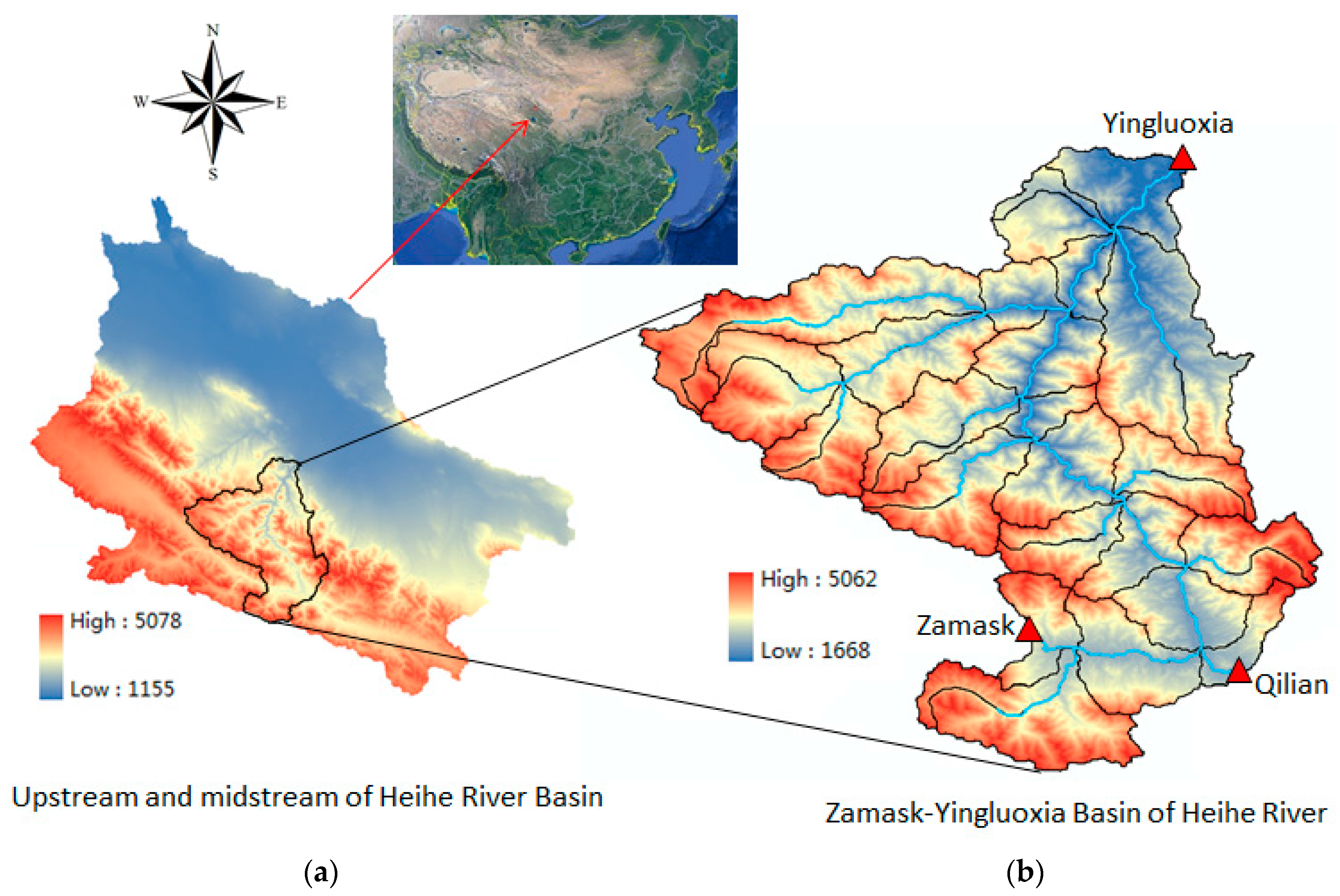

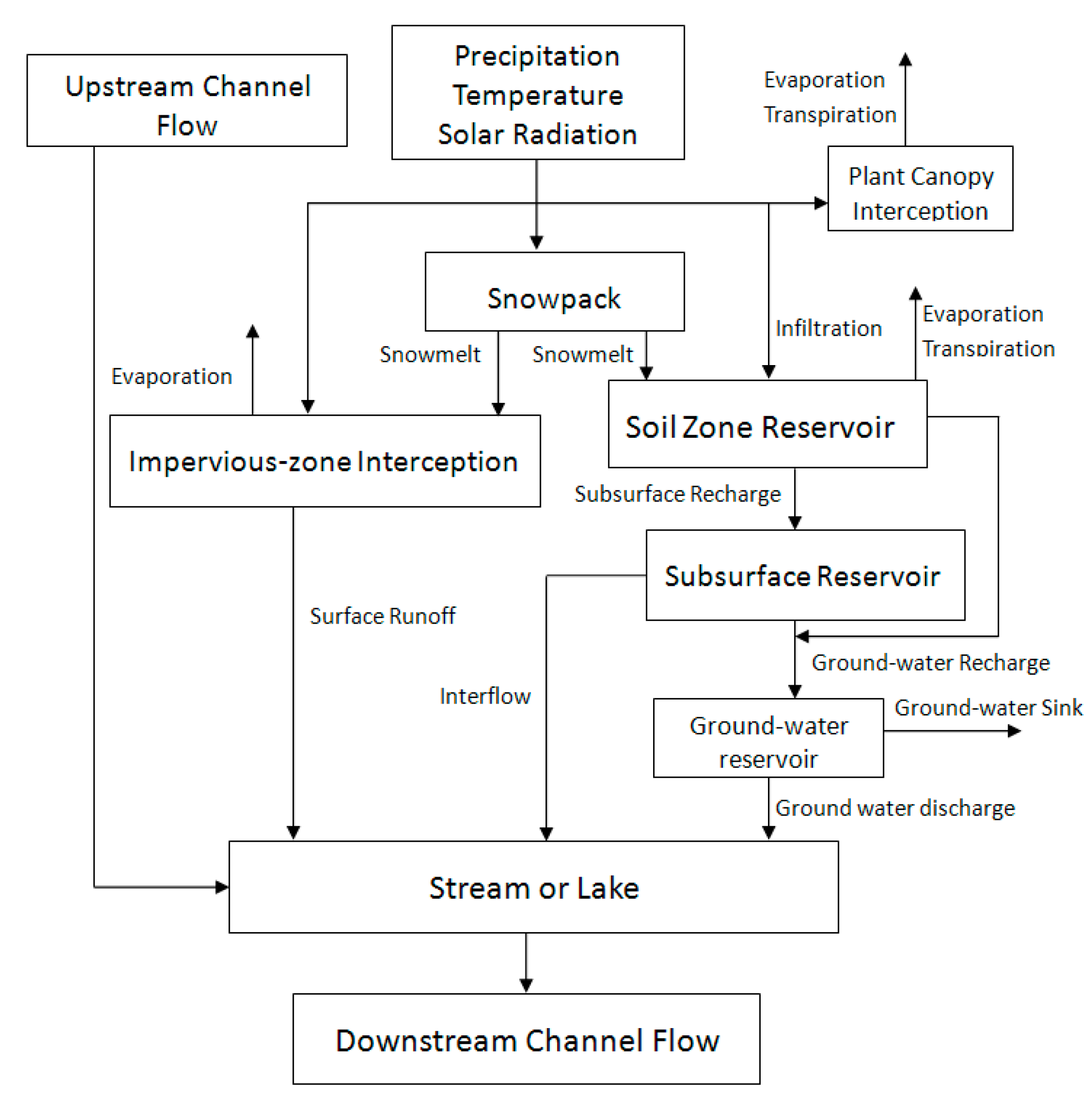
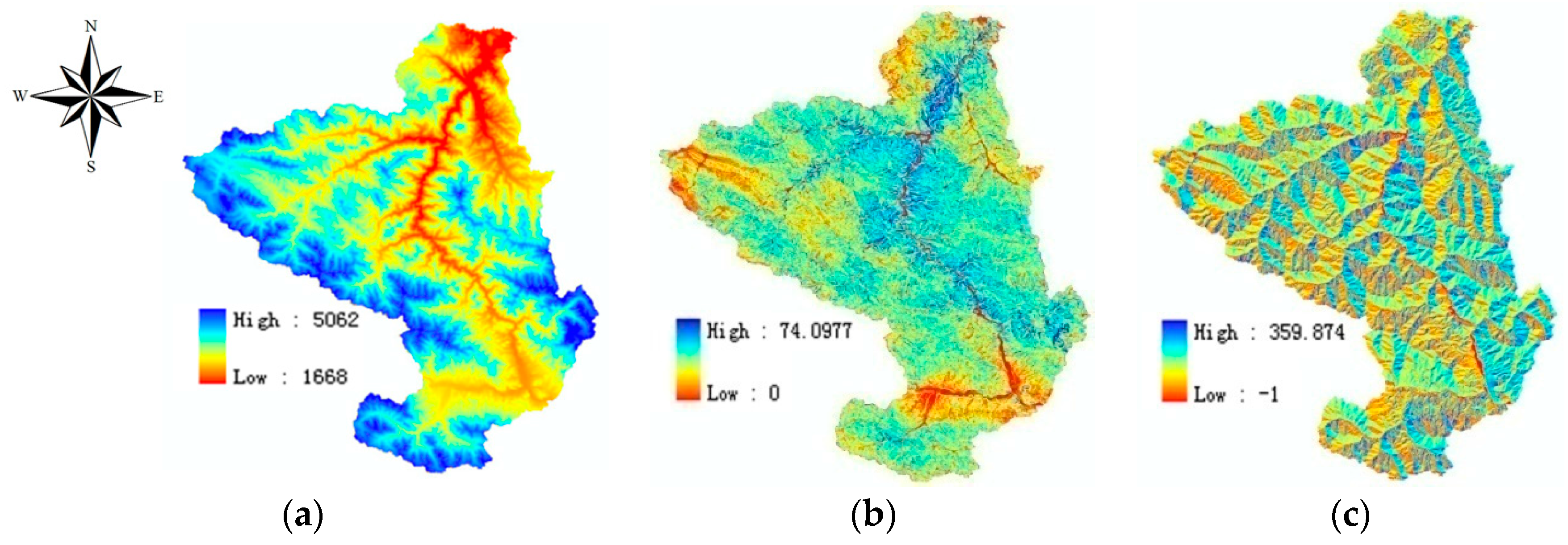
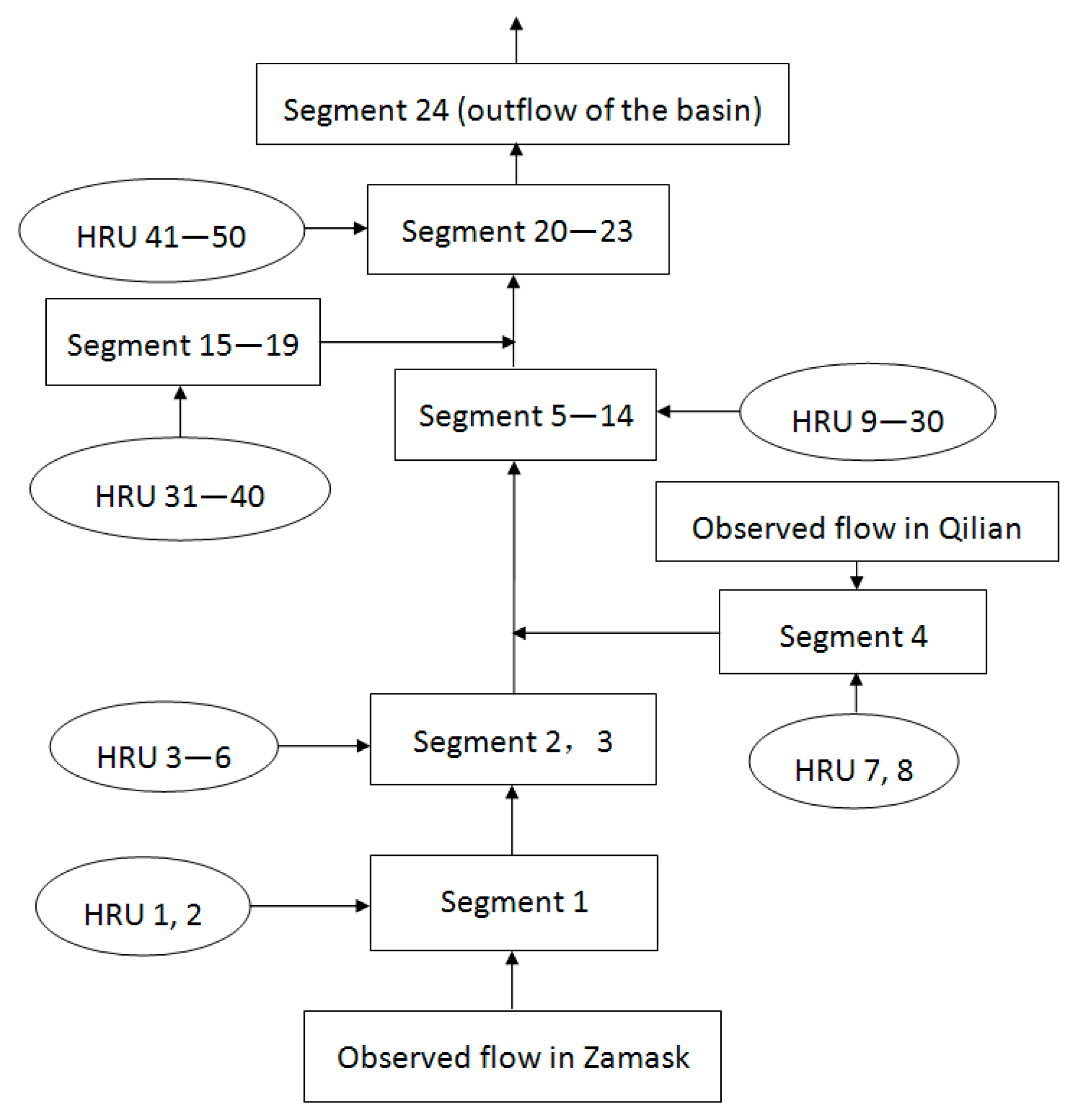
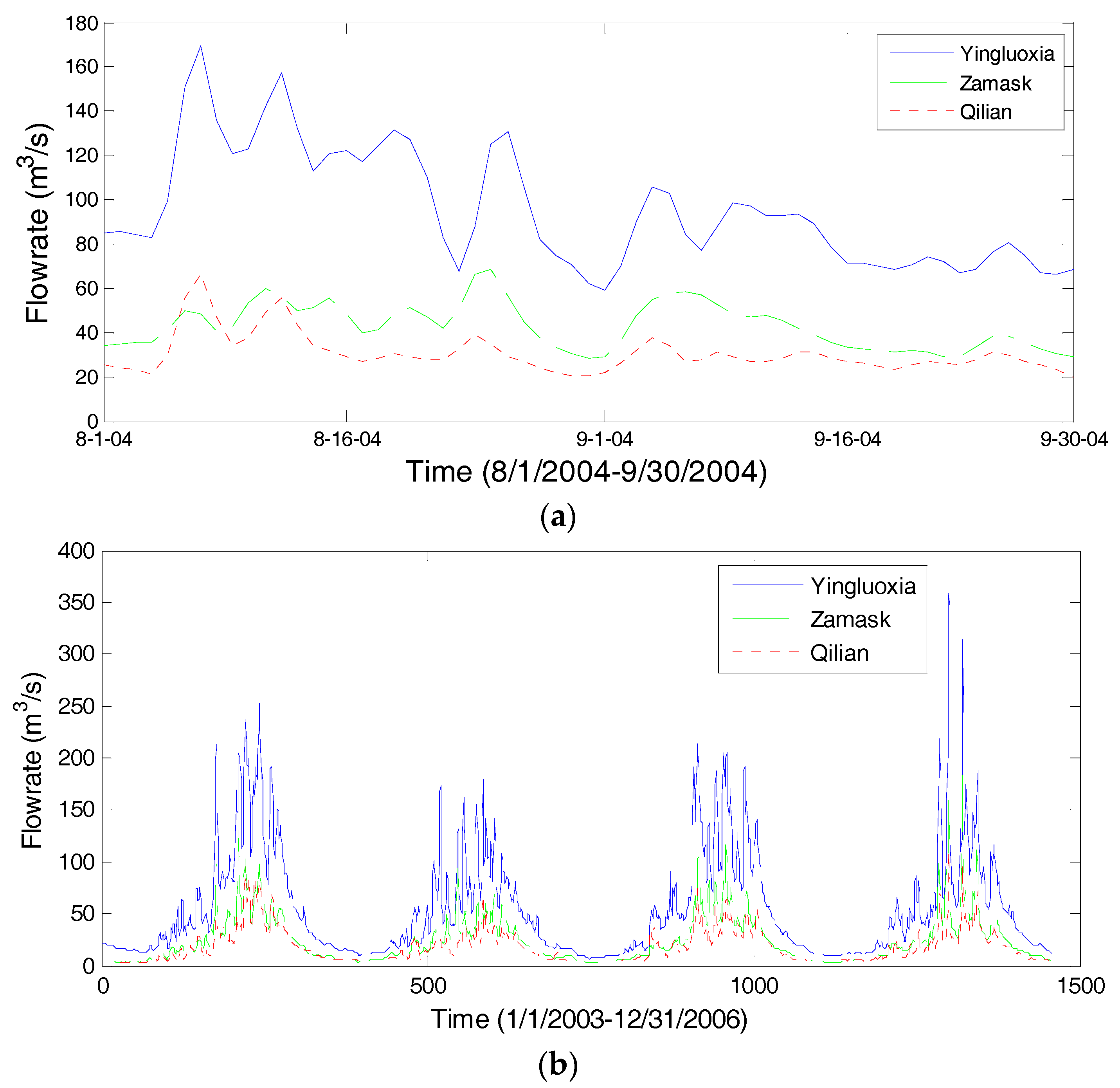
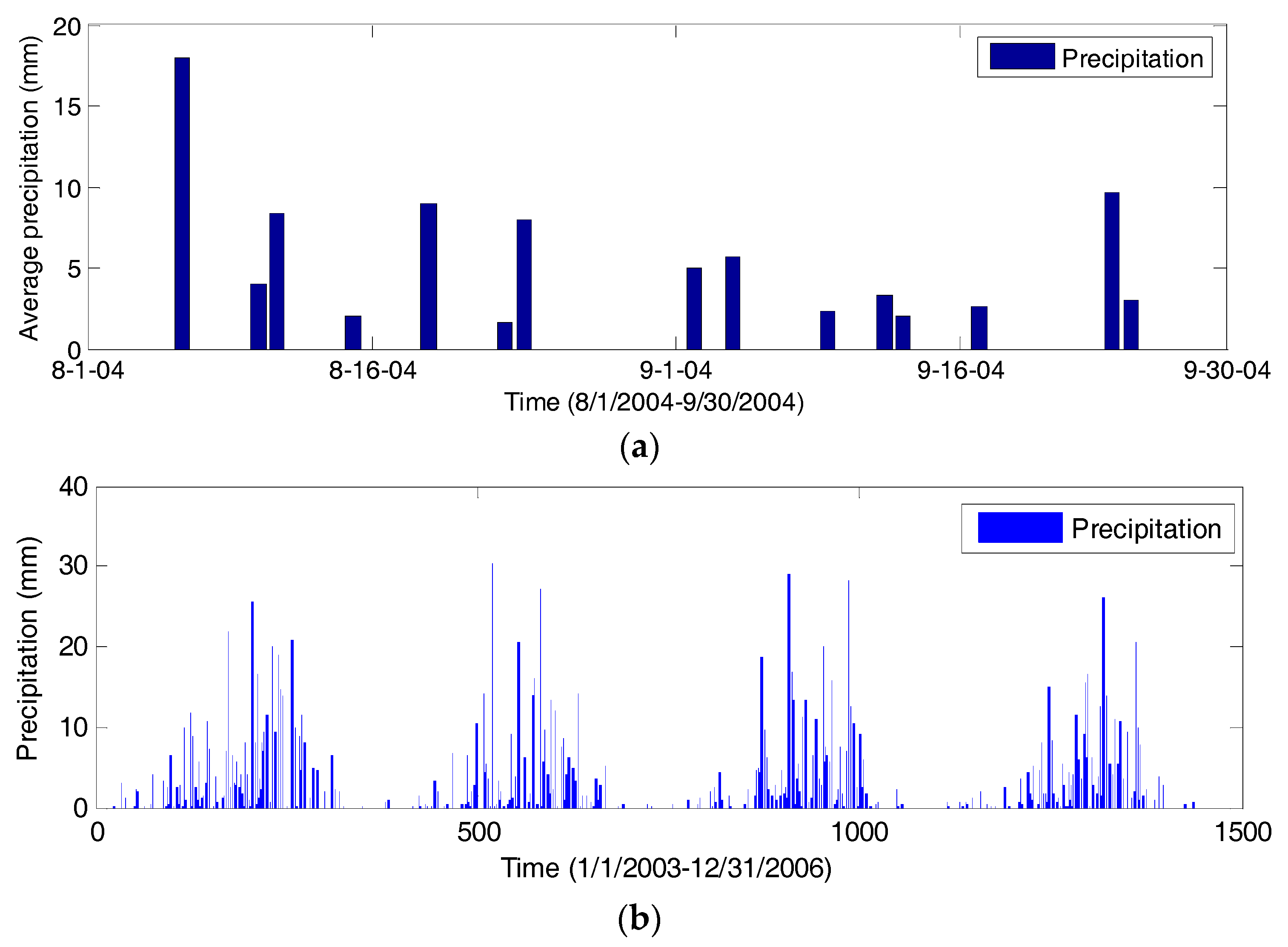
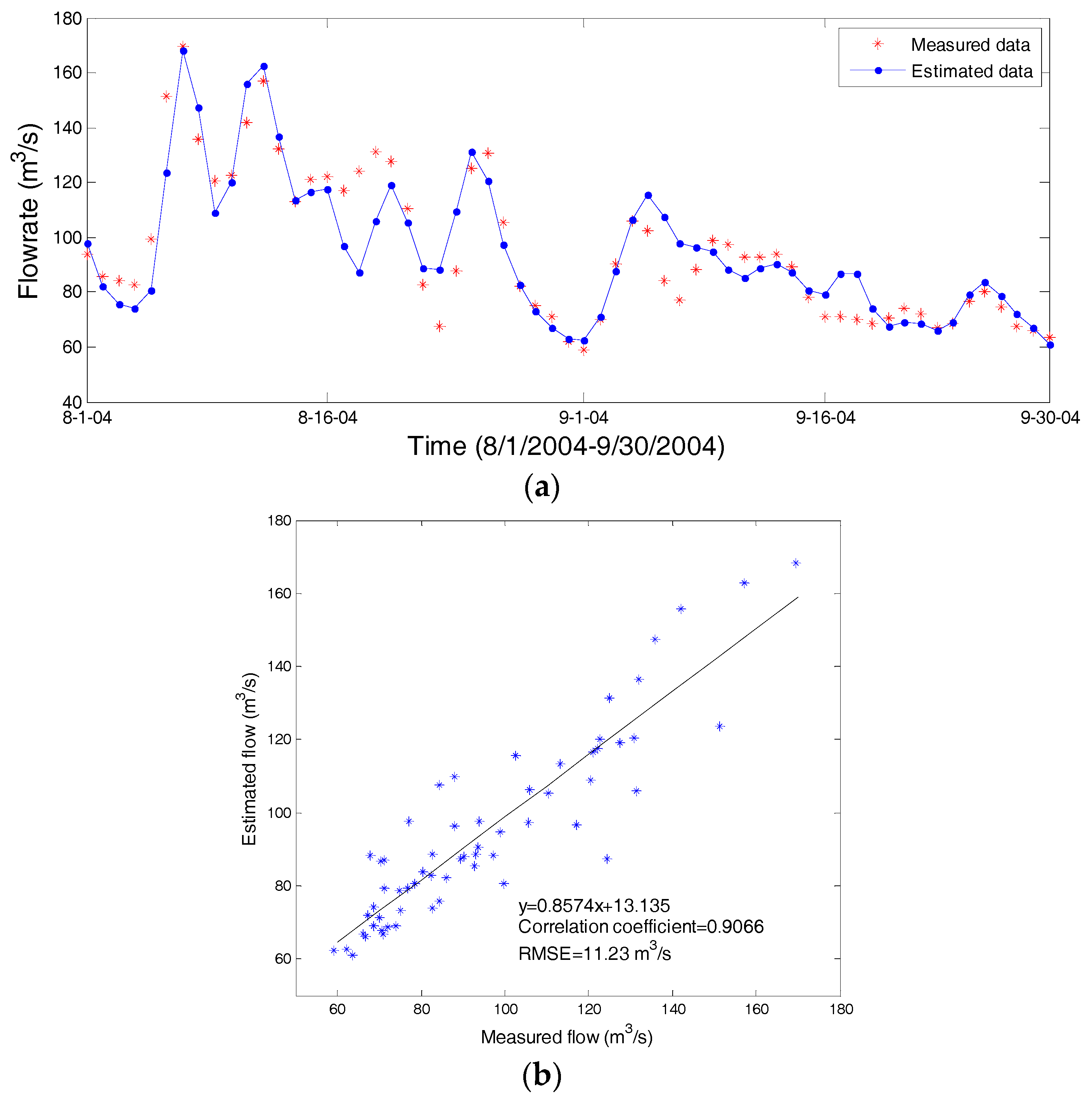

| Module | Parameters | Mean Value |
|---|---|---|
| Surface | dprst_flow_coef: Coefficient in linear flow routing equation for open surface depressions | 0.2 |
| sro_to_dprst: Fraction of pervious and impervious surface runoff that flows into surface depressions; the remainder flows to a stream network | 0.5 | |
| smidx_coef: Coefficient in non-linear contributing area algorithm | 0.22 | |
| Soil | pref_flow_den: Decimal fraction of the soil zone available for preferential flow | 0.11 |
| ssr2gw_rate: Linear coefficient in the equation used to compute gravity drainage to PRMS groundwater reservoir | 0.3 | |
| Baseflow | gwflow_coef: Linear coefficient to route water in groundwater reservoir to streams | 0.02 |
| Reach | K_coef: Travel time of flood wave from one segment to the next downstream segment, called the Muskingum storage coefficient | 1.3 |
| Model Name (Authors) | Water-Heat Coupled Model (Chen, et al. [24]) | Model Based on SME 3 (Jiao and Xu [8]) | GISMOD 4 (Li et al. [27]) | SWAT (Li et al. [25]; Wu et al. [26]) | PRMS (Present Study) |
|---|---|---|---|---|---|
| Region | Heihe upstream basin | Heihe upstream basin | Heihe upstream basin | Heihe upstream and midstream basin | Zamask-Yingluoxia subbasin |
| Period Calibration Verification | 2000 1999 | 2000 1995–1999 | 1990–1993 | 2009 2010 | 8–9/2004 2003–2006 |
| Correlation coefficient | 0.77 | Not available | Not available | 0.87 (calib. 1), 0.89 (verif.) | 0.90 (calib.), 0.95 (verif.) |
| Nash-Sutcliffe efficiency coefficient | 0.627 | 0.46–0.62 | 0.7–0.71 | 0.88 (calib.), 0.87 (verif.) | 0.82 (calib.), 0.90 (verif.) |
| Root mean square error (m3/s) | 34.9 | Not available | Not available | Not available | 11.2 (calib.), 15.7 (verif.) |
| Error of maximum flow (m3/s) | 130 2 (calib.), 350 (verif.) | 60 (calib.), 30 (verif.) | Not available | 30 (calib.), 35 (verif.) | 1.4 (calib.), 6.9 (verif.) |
| Components of Stream Flow | Surface Runoff | Interflow | Groundwater Recharge |
|---|---|---|---|
| Percentage of the stream flow | 48.4% | 21.0% | 30.6% |
© 2017 by the authors. Licensee MDPI, Basel, Switzerland. This article is an open access article distributed under the terms and conditions of the Creative Commons Attribution (CC BY) license (http://creativecommons.org/licenses/by/4.0/).
Share and Cite
Teng, F.; Huang, W.; Cai, Y.; Zheng, C.; Zou, S. Application of Hydrological Model PRMS to Simulate Daily Rainfall Runoff in Zamask-Yingluoxia Subbasin of the Heihe River Basin. Water 2017, 9, 769. https://doi.org/10.3390/w9100769
Teng F, Huang W, Cai Y, Zheng C, Zou S. Application of Hydrological Model PRMS to Simulate Daily Rainfall Runoff in Zamask-Yingluoxia Subbasin of the Heihe River Basin. Water. 2017; 9(10):769. https://doi.org/10.3390/w9100769
Chicago/Turabian StyleTeng, Fei, Wenrui Huang, Yi Cai, Chunmiao Zheng, and Songbin Zou. 2017. "Application of Hydrological Model PRMS to Simulate Daily Rainfall Runoff in Zamask-Yingluoxia Subbasin of the Heihe River Basin" Water 9, no. 10: 769. https://doi.org/10.3390/w9100769




